
A bluebell wood is a woodland that in springtime has a carpet of flowering bluebells underneath a newly forming leaf canopy. The thicker the summer canopy, the more the competitive ground-cover is suppressed, encouraging a dense carpet of bluebells, whose leaves mature and die down by early summer. Other common woodland plants which accompany bluebells include the yellow rattle and the wood anemone.

Hyacinthoides non-scripta is a bulbous perennial plant, found in Atlantic areas from north-western Spain to the British Isles, and also frequently used as a garden plant. It is known in English as the common bluebell or simply bluebell, a name which is used in Scotland to refer to the harebell, Campanula rotundifolia. In spring, H. non-scripta produces a nodding, one-sided inflorescence of 5–12 tubular, sweet-scented violet–blue flowers, with strongly recurved tepals, and 3–6 long, linear, basal leaves.

The Bluebell Railway is an 11 mi (17.7 km) heritage line almost entirely in West Sussex in England, except for Sheffield Park which is in East Sussex. It is managed by the Bluebell Railway Preservation Society. It uses steam trains which operate between Sheffield Park and East Grinstead, with intermediate stations at Horsted Keynes and Kingscote.

HMS Bluebell was a Flower-class corvette that served in the Royal Navy in World War II. Ordered from Fleming & Ferguson of Paisley, Scotland on 27 July 1939, she was launched on 24 April 1940 and commissioned in July 1940. She served in the Atlantic, Mediterranean and Arctic campaigns, escorting several convoys to Russia, and also took part in the invasions of Sicily and France. She was torpedoed and sunk by U-711 under the command of Hans-Günther Lange in the Kola Inlet on 17 February 1945 while escorting the convoy RA-64 from Murmansk. Only one member of her crew survived.

Donald and Douglas are two anthropomorphic twin steam locomotives from The Railway Series books by the Rev. W. Awdry. They also appear in Thomas & Friends, the television series based on the books. Actor Joe Mills is the voice of both Donald & Douglas.

Campanula rotundifolia, the harebell, Scottish bluebell, or bluebell of Scotland, is a species of flowering plant in the bellflower family Campanulaceae. This herbaceous perennial occurs in Europe from the north Mediterranean to the arctic. In Scotland, it is often known simply as bluebell. It is the floral emblem of Sweden where it is known as small bluebell. It produces its violet-blue, bell-shaped flowers in late summer and autumn.
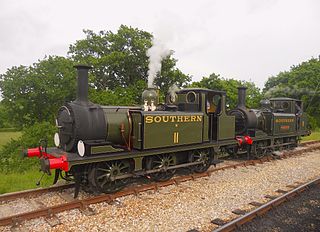
The London, Brighton and South Coast Railway (LB&SCR) A1 Class is an English class of 0-6-0T steam locomotive. Designed by William Stroudley, 50 members of the class were built in 1872 and between 1874 and 1880, all at Brighton Works. The class has received several nicknames, initially being known as "Rooters" by their south London crews. However, the engines were more famously known as "Terriers" on account of the distinctive 'bark' of the exhaust beat. Later in their careers, some engines were known as "Hayling Billy" on account of their work on the Hayling Island branch line. A pub of this name on the island was briefly home to the engine which is now No.W8 Freshwater.

Mertensia is a genus of flowering plants in the family Boraginaceae. They are perennial herbaceous plants with blue or sometimes white flowers that open from pink-tinged buds. Such a change in flower color is common in Boraginaceae and is caused by an increase of pH in the flower tissue. Mertensia is one of several plants that are commonly called "bluebell". In spite of their common name, the flowers are usually salverform (trumpet-shaped) rather than campanulate (bell-shaped).

Wahlenbergia gloriosa, commonly known as royal bluebell is a perennial herb in the bluebell family Campanulaceae. It has egg-shaped leaves near the base of its stem, linear leaves higher up and usually a single purple flower with a tube-shaped base. The flower is the floral emblem of the Australian Capital Territory.
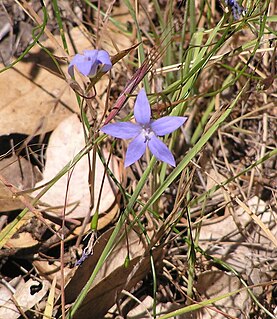
Wahlenbergia stricta, the Australian bluebell, tall bluebell or austral bluebell, is an Australian wildflower from the Campanulaceae family. It is considered the most commonly encountered of the Wahlenbergias. It is found in all Australian states but not the Northern Territory. It is often seen growing by the side of the road, enjoying the extra runoff.

Kingscote railway station is a preserved railway station on the heritage Bluebell Railway, located in West Sussex, England.

Sheffield Park is the southern terminus of the Bluebell Railway and also the headquarters of the line. It is located on the southern bank of the River Ouse and is also situated on the Greenwich Meridian.
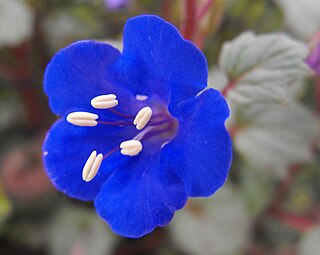
Phacelia campanularia is a species of flowering plant in the borage family, Boraginaceae, known by the common names desertbells, desert bluebells, California-bluebell, desert scorpionweed, and desert Canterbury bells. Its true native range is within the borders of California, in the Mojave and Sonoran Deserts, but it is commonly cultivated as an ornamental plant and it can be found growing elsewhere as an introduced species.

Bluebell is a small suburb of Dublin City, Ireland. Situated approximately 6.5 kilometres south-west of the city centre on the Camac, a Liffey tributary, the suburb borders the Grand Canal and Inchicore to the north, Walkinstown to the south, Drimnagh to the east, and Kylemore to the west.

Mertensia ciliata is a species of flowering plant in the borage family known by the common names tall fringed bluebells, mountain bluebells, and streamside bluebells.
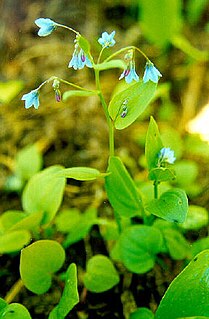
Mertensia bella is a species of flowering plant in the borage family known by the common names beautiful bluebells and Oregon lungwort. It is native to the northwestern United States, where it grows in wet mountain habitat. It is a perennial herb producing a slender, erect stem and caudex unit up to half a meter tall. The rough-haired leaves are alternately arranged and borne on petioles. The inflorescence is an open array of clustered bright blue, bell-shaped flowers up to a centimeter wide at the lobed mouths.

Mertensia oblongifolia is a species of flowering plant in the borage family known by the common names oblongleaf bluebells and sagebrush bluebells.
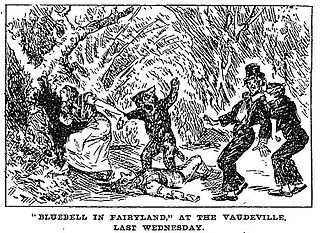
Bluebell in Fairyland is a Christmas-season children's entertainment described as "a musical dream play", in two acts, with a book by Seymour Hicks, lyrics by Aubrey Hopwood and Charles H. Taylor, and music by Walter Slaughter. It was produced by Charles Frohman. The creators sought to distinguish the work from a Christmas pantomime. The story concerns a flower girl, Bluebell, who on Christmas Eve goes to fairyland in search of the "Sleeping King", seeking to restore him to his throne, which has been usurped by the "Reigning King".
Primula capillaris is a rare species of flowering plant in the primrose family known by the common name Ruby Mountains primrose, or Ruby Mountain primrose. It is endemic to Nevada in the United States, where it is limited to the Ruby Mountains of Elko County.
Viola frank-smithii is a rare species of violet known by the common name Frank Smith's violet. It is endemic to Utah in the United States, where it is known only from Logan Canyon in the Bear River Range in Cache County.



















